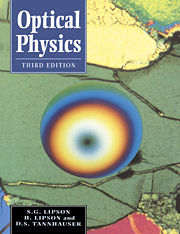Book contents
- Frontmatter
- Contents
- Preface to the third edition
- Preface to the second edition
- Preface to the first edition
- 1 History of ideas
- 2 Waves
- 3 Geometrical optics
- 4 Fourier theory
- 5 Electromagnetic waves
- 6 Polarization and anisotropic media
- 7 Diffraction
- 8 Fraunhofer diffraction and interference
- 9 Interferometry
- 10 Optical waveguides and modulated media
- 11 Coherence
- 12 Image formation
- 13 The classical theory of dispersion
- 14 Quantum optics and lasers
- 15 Problems
- Appendix 1 Bessel functions in wave optics
- Appendix 2 Lecture demonstrations in Fourier optics
- Bibliography
- Index
Preface to the first edition
- Frontmatter
- Contents
- Preface to the third edition
- Preface to the second edition
- Preface to the first edition
- 1 History of ideas
- 2 Waves
- 3 Geometrical optics
- 4 Fourier theory
- 5 Electromagnetic waves
- 6 Polarization and anisotropic media
- 7 Diffraction
- 8 Fraunhofer diffraction and interference
- 9 Interferometry
- 10 Optical waveguides and modulated media
- 11 Coherence
- 12 Image formation
- 13 The classical theory of dispersion
- 14 Quantum optics and lasers
- 15 Problems
- Appendix 1 Bessel functions in wave optics
- Appendix 2 Lecture demonstrations in Fourier optics
- Bibliography
- Index
Summary
There are two sorts of textbooks. On the one hand, there are works of reference to which students can turn for the clarification of some obscure point or for the intimate details of some important experiment. On the other hand, there are explanatory books which deal mainly with principles and which help in the understanding of the first type.
We have tried to produce a textbook of the second sort. It deals essentially with the principles of optics, but wherever possible we have emphasized the relevance of these principles to other branches of physics – hence the rather unusual title. We have omitted descriptions of many of the classical experiments in optics – such as Foucault's determination of the velocity of light – because they are now dealt with excellently in most school textbooks. In addition, we have tried not to duplicate approaches, and since we think that the graphical approach to Fraunhofer interference and diffraction problems is entirely covered by the complex-wave approach, we have not introduced the former.
For these reasons, it will be seen that the book will not serve as an introductory textbook, but we hope that it will be useful to university students at all levels. The earlier chapters are reasonably elementary, and it is hoped that by the time those chapters which involve a knowledge of vector calculus and complex-number theory are reached, the student will have acquired the necessary mathematics.
- Type
- Chapter
- Information
- Optical Physics , pp. xvii - xviiiPublisher: Cambridge University PressPrint publication year: 1995



